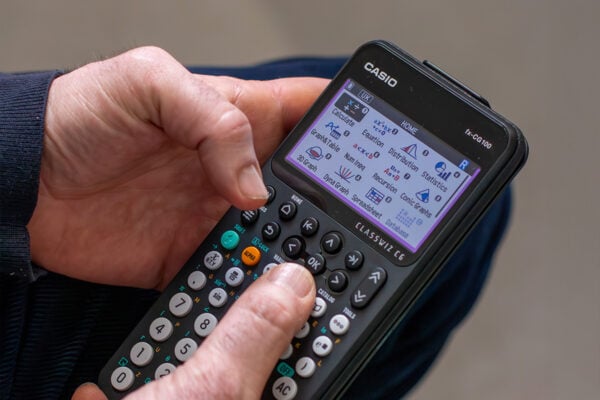Finding the Maths in Christmas – All the way from decorations to gift wrapping

We get it, how could we possibly link Maths to Christmas? It seems pretty tenuous, right? When you think of Christmas, Maths probably doesn’t immediately spring to mind. But, you may be surprised to learn the few hidden ways that Maths can help us out. If we use Maths to our advantage, it can make other aspects of our lives more seamless – like Christmas.
Believe it or not, using some basic maths, we can make Christmas a lot less stressful, while saving the environment at the same time.
Reduce wastage from gift wrapping
A Mathematician called Dr Sara Santos developed a smart formula for wrapping square presents which helps to reduce wastage. It gets better; the formula also helps match patterns together at the join – you could be the ultimate gift wrapper! Dr Santos made her debut when she shared this secret technique on The One Show.
The exact formula Dr Santos uses may look a bit complicated when written down but bear with us. It looks like this:
1/2 (d+2h+w)² = 2(w+h)²
You don’t need to wrack your brain to work it out. We’ve got you covered, here’s the step-by-step method:
- Firstly, take your square gift and measure the diagonal of its largest side in centimetres (if it’s a cube, measure the diagonal of any side).
- Add this measurement to one-and-a-half times the present’s height. The result is the measurement in cm you’re going to use for the four sides of a square on your wrapping paper (so if the outcome of your sum is 28, you’re going to measure out a 28 x 28 cm square on your gift wrap).
- Cut out the square. Then, place your gift diagonally in the centre of the paper. When viewed from above, your gift will look like a diamond inside a square.
- Bring in the four corners and then fold in the tabs that are created. If you are using a simple patterned paper, such as a stripe, these should also match up at the joins. Add a bow and a gift tag, and you’ve got one perfectly wrapped present.
Dr Santos’s formula also works for oblong presents – except, in this case, it’s not quite advanced enough to make the pattern match up.
The perfect ratio of baubles to Christmas tree
We’ve all been there, you spend hours decorating your tree, and you think you’ve nailed it. But then you stand back and well, it’s not quite what you had in mind. One side has too many baubles, the other side not enough, the colours aren’t even – it all just looks a bit ‘off’.
If you want your Christmas tree to look spot on, take a tip from Sheffield University Maths Society. They developed a series of formulae to stop your creation in the corner of the living room looking too cluttered. Just make sure you have the height of your tree handy for reference.
Pi – or Π – (approximately 3.141592) is not only a mathematical device useful for measuring circles; it works with tinsel and tree lights too!
You’ll need to grab your calculator for the next bit. For the amount of tinsel required to go round your tree, multiply Π by 13, then divide it by eight. Multiply the result by the height (in cm) of your tree. Your answer is the optimum length of tinsel, in cm, that will look perfect draped around the branches.
What about the lights? It’s a little easier to work out how many tree lights are required. Multiply the height of your tree, in cm, by Π to reveal the best length, also in cm.
You won’t need Π for your baubles. Instead, Sheffield University suggests you first take the square root of 17 (around 4.123) and divide it by 20. Multiply the result by the height of your tree in cm. This gives the ideal number of baubles which are just right for arranging in regularly spaced gaps around the branches.
Father Christmas’ big night out
No matter what age you are, we can all appreciate that there’s a little magic at Christmas. Whether you’re 4 or 40 the Christmas spirit manages to find a way in. The age-old question we’ve all asked at some point is ‘How does Father Christmas find the time to deliver all those presents to so many well-behaved children in just one evening?’ He must have to maintain an impressive average speed in miles per hour.
Father Christmas maths expert Larry Silverberg, a professor of mechanical and aerospace engineering at North Carolina State University, has been able to crunch a few numbers to work out the logistics of the night before Christmas.
So, how does it work?
Father Christmas has just 24 hours to complete his deliveries. In that time, Prof Silverberg and his students have worked out he must deliver gifts to an estimated 200m, excited children. They’re spread over an area of 200m square miles and 75m homes.
With an average distance between each home of 1.63 miles, that means Father Christmas has 122m miles to cover, in just 24 hours!
But we forget that this is all possible through Christmas magic. Santa’s sleigh would need to travel at 5,083,000 mph to complete his shift and be back with Mrs Claus in time for the morning. Light travels at 669,600,000 mph, 130 times faster than Santa would need to travel at to get all those presents delivered.
Here’s the science bit. Light already exists and moves at a proven speed. Therefore, it must be possible for something to move slower than the speed of light. And because father Christmas has magical powers, it’s entirely plausible he can do just that!



